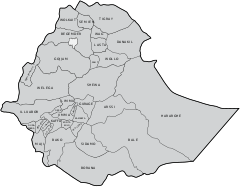Draft:Raya
Raya (Tigrinya: ራያ) is a historical area situated in the Southern part of the Tigray region of northern Ethiopia. The area is known for its rich cultural heritage and has played a pivotal role in the history of the Horn of Africa and remains one of the most famous areas in the country.
Geography[edit]
Raya is located in the northern part of Ethiopia, within the Tigray region and northern part of the Amhara region. It is characterized by its diverse landscape, including mountains, valleys, and fertile plains. The area contains cities such as Maychew, Chercher, Korem, Alamata, Waja, Mekhoni, Kobo, Weldiya and Wajjirat. The region is bordered by other historical areas such as Lasta to the south and Wollo to the west.
History[edit]

Raya has a long and illustrious history dating back to ancient times. Raya's proximity to the ancient Aksumite Empire contributed to its importance as a commercial center and a hub for civilization in the region. Ethnically, the population of Raya is mixed, however is predominantely Tigrayan in the northern part of the area, the southern part of Raya is mostly inhabited by Amharas in Kobo and Weldiya with a strong tigrayan minority.[1]
Historically, Raya was split into two provinces: The southern part of the Tigray province, home to towns such as Chercher, Mehoni, Wajjirat and Maychew. And the complete Wag Province, home to cities such as Alamata, Korem, Kobo and Weldiya. These areas were majority Tigrayan with a minority Amharas and Oromos living in Southern Wag.[2][3]
Haile Selassie[edit]

This was the political, ethnic and geographic structure of Raya until 1944 when Wag Province was incorporated into the Wollo province. This decision by Emperor Haile Selassie aimed to punish Tigray for the first Woyane rebellion. The uprising, led by Tigrayan farmers, was a response to Haile Selassie's plans to centralize power in Ethiopia around the government in Shewa, which went against the Tigrayan people's desire for self-determination. By assigning Tigrayan majority Wag into Amhara-dominated Wello, Haile Selassie defeated any chance of Tigrayan unity and succesfully prevented further uprisings against him.[4]
Raesi Mengesha Seyoum, the last monarch prince in Tigray, attested to the fact that, during his youth, all of Southern Tigray to Alwuha Milash belonged to Tigrayans. However, portions of Southern Tigray were taken from the control of tigrayans in the 1940s by Haile Selassie as a punitive measure and to expand Amhara influence.[2] After this the area of Raya was seperated and put in different so called Awrajjas with different administrations, the Raya part in Tigray was named Raya Azebo, and the part in Wello was named Raya Kobo.[5]
TPLF[edit]
However in 1991, with the rise of TPLF, the administrial borders of Ethiopia changed to fit ethnicity and thus the Tigrayan parts of Raya Kobo in Wello were put into te Tigray Region while certain cities in the southern part of Raya, which were majority Amhara and Oromo, stayed in the Amhara region such as Kobo and Weldiya. However, even these cities have significant Tigrayan minorities even today.[6]
This has caused issues with many Amhara Nationalists claiming that the Tigrayan majority land of Raya must be incoprorated into te Amhara region. This is one of the factors that led to the Tigray War (2020-2022) and has caused mass-slaughters against the Tigrayans of Raya.[6]
The War on Tigray[edit]


During the war, the Tigray Region was attacked by the Amhara militia Fano and there were mass killings reported against the civilians in Raya. Mass rape, forced deportations and ethnic oppression became a normal part of life for the people of Raya. Human Rights Watch and Amnesty International, two of the world´s most respected Non-Governmental Organizations both wrote articles expressing their concerns about the events.
HRW says "Civilian structures in towns in Tigray, including hospitals, schools, factories, and businesses, were shelled, looted and destroyed by Ethiopian federal forces and regional militias, and by Eritrean armed forces. The fighting and continued restrictions on humanitarian access forced more than two million people to flee their homes"[7]. Raya has been strongly hit by this due to the claims of "theft" by TPLF which has resulted in areas such as Alamata, Korem and Waja being hardly hit.
Culture and Heritage[edit]

Raya boasts a vibrant cultural heritage characterized by its unique traditions, art, music, and cuisine. The region is known for its distinctive architectural style, including ancient churches, monasteries, and traditional dwellings. The people of Raya has a special form of dancing with long sticks while chanting and running. Certain commons phrases used in their dancing are: "Gumaye", "Hura", Hoya Hoye", "Raya Rayuma" and "Meqelle Semere".

The people of Raya have preserved their cultural identity through generations, celebrating festivals, rituals, and ceremonies that reflect their history and beliefs. The region's cultural landscape is also enriched by it's cities each contributing to the tapestry of Raya's heritage.
Raya remains a fascinating and historically significant region, embodying the resilience, diversity, and enduring spirit of its people. Its rich history and cultural legacy is a fascinating tapestry of Tigray's past and present.
References[edit]
- ^ Weldemariam, Alemayehu (2019-03-24). "Raya: a category error, and a catalog of errors". Ethiopia Insight. Retrieved 2024-03-22.
- ^ a b Ras mengesha sium briefly explained on the border of tigray, retrieved 2024-03-18
- ^ "Questioning the Tigrai identity of Raya people is a declaration of war on Tigrai state". Tigrai Online. Retrieved 2024-03-18.
- ^ "Woyane rebellion". Military Wiki. Retrieved 2024-03-18.
- ^ Weldemariam, Alemayehu (2019-03-24). "Raya: a category error, and a catalog of errors". Ethiopia Insight. Retrieved 2024-03-22.
- ^ a b "Questioning the Tigrai identity of Raya people is a declaration of war on Tigrai state". Tigrai Online. Retrieved 2024-03-18.
- ^ "Tigray Conflict | Human Rights Watch". www.hrw.org. Retrieved 2024-03-18.
